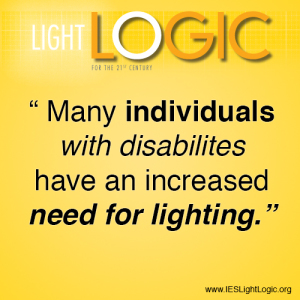Learn About Lighting
 Universal design is a way of integrating accessibility features seamlessly into the architectural environment. But doesn’t that only matter for add-ons, such as ramps or chair lifts? Of course not! Truly accessible design changes the way we integrate even the most common aspects of a home, such as lighting. Being mindful of a range of physical challenges and abilities means reconsidering how every aspect of the home comes together for diverse users. Read more to learn about lighting design for people with disabilities.
Universal design is a way of integrating accessibility features seamlessly into the architectural environment. But doesn’t that only matter for add-ons, such as ramps or chair lifts? Of course not! Truly accessible design changes the way we integrate even the most common aspects of a home, such as lighting. Being mindful of a range of physical challenges and abilities means reconsidering how every aspect of the home comes together for diverse users. Read more to learn about lighting design for people with disabilities.
Avoiding Lighting Glare
When it comes to home lighting, one difficulty common to wheelchair users is glare. The positioning and design of lights in your average home often results in light shining directly in their eyes, because these individuals are at a lower vantage point. Lighting that is positioned under cabinets, or lights that are similarly angled down pose particular problems for these individuals. Positioning lights at a lower level, or installing fixtures with reduced glare can resolve this problem.
Light for Navigation
Many individuals with disabilities have an increased need for lighting, to compensate for poor vision or other spatial navigation difficulties. In accessibly designed homes this often translates to installing ground track lighting along hallways and outdoor pathways. LED lighting is ideal for this purpose and can be placed flush against walls or the outside of pathways to prevent users from tripping or getting caught. This “extra” lighting helps everyone to see more easily, avoiding falls, and aiding in navigation. Other places that supplemental lighting might be placed are around door locks, near grab rails, or other room landmarks.
Integrating Motion Sensors
One way to integrate lighting for accessibility and safety is by installing motion sensors. Particularly in bathrooms and outdoor areas, motion sensors can increase safety and prevent individuals from fumbling around for a light switch. Larger rocker-style light switches that are easier to use for those with poor fine motor skills should also be a feature in accessibly designed homes.
Easy Access Light Switches
The inaccessibility of light switches is one of the most common problems that individuals with disabilities face when it comes to lighting access. Many light switches are placed too high for individuals who use wheelchairs. Similarly, it is common for light switches to be placed at the back of counters, blocking access. Universal design principles recommend that light switches be placed at a height of about 36 inches and never at a height of more than 44 inches or at the back of counters.